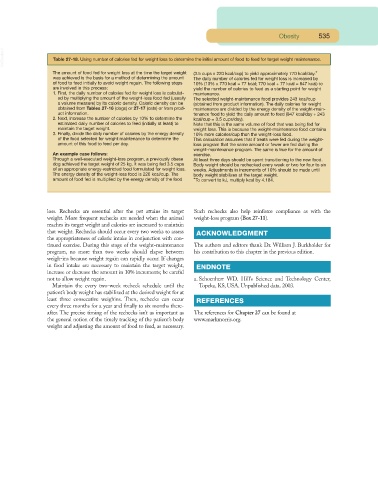Page 519 - Small Animal Clinical Nutrition 5th Edition
P. 519
Obesity 535
VetBooks.ir Table 27-18. Using number of calories fed for weight loss to determine the initial amount of food to feed for target weight maintenance.
The amount of food fed for weight loss at the time the target weight (3.5 cups x 220 kcal/cup) to yield approximately 770 kcal/day.*
was achieved is the basis for a method of determining the amount The daily number of calories fed for weight loss is increased by
of food to feed initially to avoid weight regain. The following steps 10% (10% x 770 kcal = 77 kcal; 770 kcal + 77 kcal = 847 kcal) to
are involved in this process: yield the number of calories to feed as a starting point for weight
1. First, the daily number of calories fed for weight loss is calculat- maintenance.
ed by multiplying the amount of the weight-loss food fed (usually The selected weight-maintenance food provides 243 kcal/cup
a volume measure) by its caloric density. Caloric density can be (obtained from product information). The daily calories for weight
obtained from Tables 27-16 (dogs) or 27-17 (cats) or from prod- maintenance are divided by the energy density of the weight-main-
uct information. tenance food to yield the daily amount to feed (847 kcal/day ÷ 243
2. Next, increase the number of calories by 10% to determine the kcal/cup = 3.5 cups/day).
estimated daily number of calories to feed (initially at least) to Note that this is the same volume of food that was being fed for
maintain the target weight. weight loss. This is because the weight-maintenance food contains
3. Finally, divide the daily number of calories by the energy density 10% more calories/cup than the weight-loss food.
of the food selected for weight maintenance to determine the This calculation assumes that if treats were fed during the weight-
amount of this food to feed per day. loss program that the same amount or fewer are fed during the
weight-maintenance program. The same is true for the amount of
An example case follows: exercise.
Through a well-executed weight-loss program, a previously obese At least three days should be spent transitioning to the new food.
dog achieved the target weight of 25 kg. It was being fed 3.5 cups Body weight should be rechecked every week or two for four to six
of an appropriate energy-restricted food formulated for weight loss. weeks. Adjustments in increments of 10% should be made until
The energy density of the weight-loss food is 220 kcal/cup. The body weight stabilizes at the target weight.
amount of food fed is multiplied by the energy density of the food *To convert to kJ, multiply kcal by 4.184.
loss. Rechecks are essential after the pet attains its target Such rechecks also help reinforce compliance as with the
weight. More frequent rechecks are needed when the animal weight-loss program (Box 27-11).
reaches its target weight and calories are increased to maintain
that weight. Rechecks should occur every two weeks to assess ACKNOWLEDGMENT
the appropriateness of caloric intake in conjunction with con-
tinued exercise. During this stage of the weight-maintenance The authors and editors thank Dr. William J. Burkholder for
program, no more than two weeks should elapse between his contribution to this chapter in the previous edition.
weigh-ins because weight regain can rapidly occur. If changes
in food intake are necessary to maintain the target weight, ENDNOTE
increase or decrease the amount in 10% increments; be careful
not to allow weight regain. a. Schoenherr WD. Hill’s Science and Technology Center,
Maintain the every two-week recheck schedule until the Topeka, KS, USA. Unpublished data. 2003.
patient’s body weight has stabilized at the desired weight for at
least three consecutive weighins. Then, rechecks can occur REFERENCES
every three months for a year and finally to six months there-
after. The precise timing of the rechecks isn’t as important as The references for Chapter 27 can be found at
the general notion of the timely tracking of the patient’s body www.markmorris.org.
weight and adjusting the amount of food to feed, as necessary.

